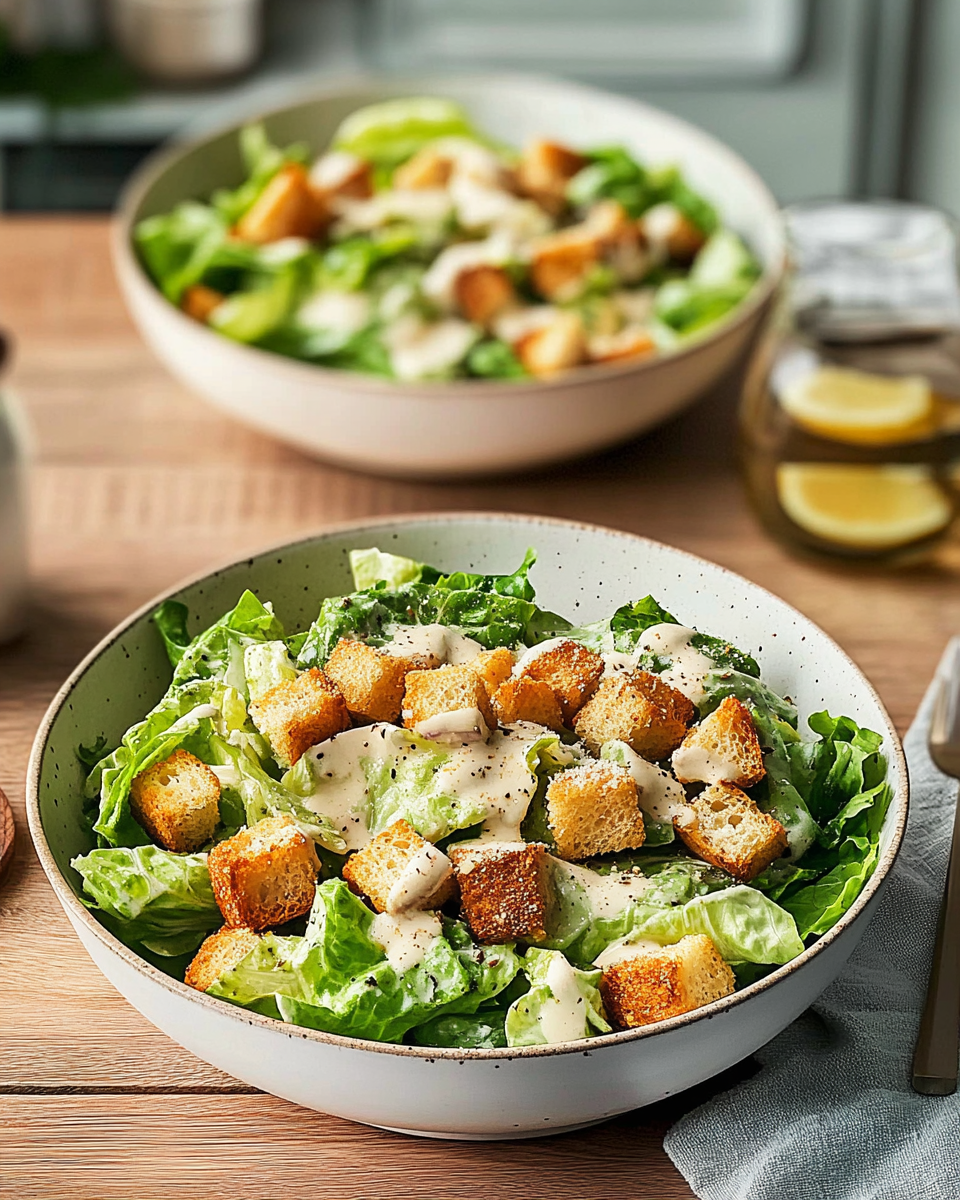A timeless favorite, this Classic Caesar Salad combines crisp romaine lettuce, crunchy croutons, and a rich, tangy homemade dressing made with fresh garlic, anchovies, and Parmesan cheese. Perfect as a light lunch or an elegant side dish, this salad delivers bold flavor and satisfying texture in every bite.
FULL RECIPE
Ingredients
- 1 large head romaine lettuce, chopped
- 1 cup croutons (store-bought or homemade)
- ¼ cup freshly grated Parmesan cheese
1.For the Dressing
- 1 large egg yolk (or 1 tbsp mayonnaise for a safer option)
- 2 anchovy fillets, finely minced
- 1 garlic clove, minced
- 1 tsp Dijon mustard
- 1 tbsp lemon juice
- ½ tsp Worcestershire sauce
- ⅓ cup olive oil
- Salt and black pepper, to taste
Directions
- Wash and dry the romaine lettuce. Tear into bite-sized pieces and set aside in a large bowl.
- In a medium bowl, whisk together the egg yolk, minced anchovies, garlic, Dijon mustard, lemon juice, and Worcestershire sauce until well combined.
- Slowly drizzle in the olive oil while whisking constantly to emulsify the dressing.
- Season with salt and freshly ground black pepper to taste.
- Pour the dressing over the lettuce and toss to coat evenly.
- Add croutons and grated Parmesan cheese; toss again lightly.
- Serve immediately, garnished with extra Parmesan if desired.
Nutritional Information
- Calories: 280
- Total Fat: 24g
- Saturated Fat: 4g
- Cholesterol: 35mg
- Sodium: 480mg
- Total Carbohydrates: 9g
- Dietary Fiber: 2g
- Sugars: 1g
- Protein: 6g
History of Caesar Salad
The Caesar salad is a classic dish with an interesting origin story. It was created in the 1920s by Italian-American restaurateur Caesar Cardini in Tijuana, Mexico. Legend has it that Cardini invented the salad on a busy Fourth of July weekend when his kitchen was running low on ingredients. Using what he had on hand, he crafted a simple yet flavorful salad that quickly became popular. Over the decades, it has evolved from a restaurant specialty to a staple in kitchens and menus worldwide, known for its distinctive dressing and crunchy texture.
The Role of Anchovies in the Dressing
Anchovies play a crucial role in authentic Caesar salad dressing, providing a subtle umami depth that enhances the overall flavor. They might seem like a small ingredient, but anchovies add a salty, savory complexity that balances the acidity of lemon juice and the creaminess of egg yolk or mayonnaise. Some variations omit anchovies due to dietary preferences, but the traditional recipe considers them essential for that classic taste.
Why Use Fresh Garlic
Fresh garlic is a key ingredient that delivers pungency and aroma to the dressing. It provides a sharp, slightly spicy flavor that complements the richness of the olive oil and Parmesan cheese. Using fresh garlic instead of garlic powder ensures a more vibrant and authentic taste, which is fundamental to capturing the essence of a traditional Caesar salad.
Egg Yolk vs. Mayonnaise in Dressing
The traditional Caesar dressing uses raw egg yolk to create a creamy, rich texture. This emulsifies the dressing and gives it a silky mouthfeel. However, for those concerned about consuming raw eggs, mayonnaise is a safe alternative that still mimics the creaminess and body of the dressing. Both options work well, but the egg yolk offers a more authentic and classic flavor profile.
The Importance of Freshly Grated Parmesan
Freshly grated Parmesan cheese is essential for both flavor and texture in a Caesar salad. Unlike pre-grated cheese, freshly grated Parmesan melts better into the dressing, adding a nutty, salty sharpness. It also contributes to the salad’s luxurious mouthfeel and enhances the overall taste complexity. High-quality Parmesan makes a noticeable difference.
Choosing the Right Romaine Lettuce
Romaine lettuce is the classic choice for Caesar salad due to its crisp texture and slightly bitter taste, which balances the creamy dressing. When selecting romaine, look for firm, vibrant green leaves that are fresh and crunchy. Avoid limp or brown-edged leaves to ensure the salad stays crisp and refreshing.
Croutons: Homemade vs. Store-bought
Croutons add essential crunch to a Caesar salad, contrasting beautifully with the tender lettuce and creamy dressing. Homemade croutons, made from day-old bread tossed in olive oil and lightly toasted, provide a fresher, more customizable option with better texture and flavor. Store-bought croutons are convenient but often lack the same crunch and can be overly salty.
Nutritional Benefits and Considerations
While Caesar salad is delicious, it’s important to consider its nutritional profile. The salad is relatively high in fat due to olive oil, Parmesan, and egg yolk or mayonnaise. However, these fats are mostly heart-healthy monounsaturated fats. Romaine provides vitamins A and K, along with fiber, which support overall health. Moderation is key to enjoying Caesar salad as part of a balanced diet.
Variations of Caesar Salad
There are many popular variations of the classic Caesar salad. Some recipes add grilled chicken or shrimp to make it a complete meal. Others include ingredients like avocado, bacon, or even kale for a twist. The dressing can also be adapted to include yogurt for a lighter version or anchovy paste for easier preparation. These variations maintain the essence while catering to different tastes.
Pairing Caesar Salad with Meals
Caesar salad pairs well with a variety of dishes, making it a versatile choice for starters or sides. It complements grilled meats, pasta dishes, and seafood beautifully. Its crispness and tangy dressing provide a refreshing contrast to rich, heavier main courses. It’s also excellent as a light lunch on its own, especially when topped with protein.
Common Mistakes to Avoid
One common mistake when making Caesar salad is overdressing the lettuce, which can make it soggy and heavy. It’s best to toss just enough dressing to coat the leaves lightly. Another mistake is using pre-grated cheese or stale croutons, which can affect texture and flavor. Lastly, not emulsifying the dressing properly can lead to separation and a less creamy finish.
How to Store Leftover Salad and Dressing
Caesar salad is best enjoyed fresh, but if you have leftovers, storing them correctly is key. Keep the dressing separate from the lettuce to prevent sogginess. Store lettuce in an airtight container in the fridge for up to a day. Dressing can be refrigerated for up to a week if kept in a sealed jar. Add croutons just before serving to retain crunch.
Cultural Impact and Popularity
The Caesar salad has become more than just a recipe; it’s a cultural icon in many parts of the world. It is frequently featured on restaurant menus, from casual eateries to fine dining establishments. Its distinctive taste and recognizable ingredients have inspired countless culinary adaptations, demonstrating its enduring popularity and versatility.
Conclusion
The Classic Caesar Salad is a dish that combines history, tradition, and bold flavors into one iconic recipe. Its simple yet thoughtful ingredients—romaine lettuce, creamy anchovy-garlic dressing, Parmesan cheese, and crunchy croutons—come together to create a dish that has stood the test of time. Whether enjoyed as a light meal or a flavorful side, understanding the origins, preparation nuances, and variations of Caesar salad enriches the dining experience and appreciation for this beloved culinary staple.






